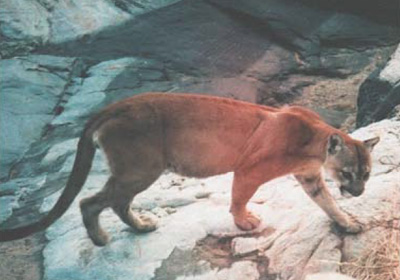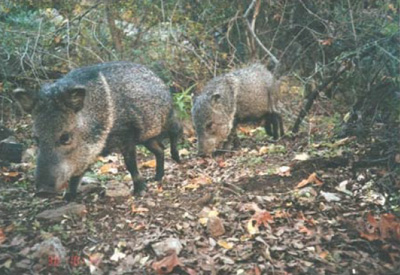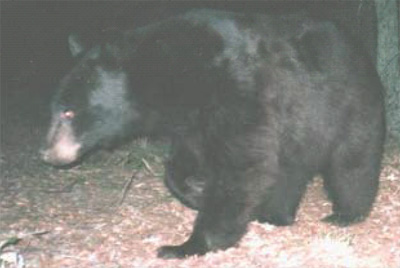Many visitors to national parks eagerly anticipate the chance to see large mammals such as bears, elk, and bighorn sheep. Yet surprisingly little is known about mammals in most parks.

NPS
Many species are elusive, nocturnal, or rare, and studying them often requires intrusive methods and significant funds. Biologists usually rely on sightings and other evidence to determine which species occur in parks, but these data may be subject to interpretation and are not ideal. Increasingly, wildlife cameras that use infrared light beams and are triggered by the animals themselves are providing new ways to learn about mammals.
We used wildlife cameras at Saguaro National Park for 10 years (1999-2008) to document the park’s medium and large mammals and where they occur. Cameras were located at random locations as well as near springs and other water sources in the park’s two districts – the Rincon Mountain District, located east of Tucson, and the Tucson Mountain District, located west of the city.
Methods
We photographed mammals using both film and digital infrared- triggered wildlife cameras. We set cameras at 41 random points throughout both districts during 2000-2003. In addition, during 1999-2008, we set cameras at more than 88 non-random points that represented the full geographic and vegetative diversity of Saguaro National Park. We checked cameras approximately once every two weeks (less frequently for digital units) to change film and trouble-shoot problems. We moved most cameras every few weeks, but a few cameras were left in the same location for extended periods to determine how many species may occur in these locations over long periods of time.
Photographs of wildlife were examined to identify the species present in each photo. Data associated with each photo, including the date, time, location, species, and number of individuals, were entered into a database for further analysis, and photos were archived at the Western Archeological Conservation Center in Tucson. For analysis, we focused only on larger mammals: opossums, squirrels, rabbits and hares, carnivores, and hoofed animals. We used a variety of statistical procedures to summarize the data and estimate the number of species present in the park (species richness) at different periods of time.
Results
During 1999-2008 we obtained more than 7,500 photographs of medium and large mammals, approximately 4,500 in the Rincon Mountain District and 3,000 in the Tucson Mountain District. We confirmed 30 species in Saguaro National Park: six squirrels, three rabbits and hares, one opossum, 16 carnivores, and four hoofed animals. We documented 21 species in the Tucson Mountain District and 29 species in the Rincon Mountain District. We did not photograph two species in the Tucson Mountains (bighorn and porcupine) and four species (bighorn, porcupine, jaguar, and Mexican gray wolf) in the Rincon Mountains that have been reliably documented at the park and may now be locally extinct. However, we did photograph two species (opossum and coati) that do not appear on early species lists and may have colonized Saguaro National Park after it was established. We photographed four non-native mammals: domestic dogs and cats, feral cattle, and the Abert’s squirrel. Estimates of species richness were similar to species counts, suggesting we photographed most species present.

NPS
Carnivores and hoofed animals
Among the largest mammals in Saguaro National Park are black bears, which we photographed only in the Rincon Mountains, and mountain lions. We obtained many more photos of mountain lions in the Rincons than in the Tucson Mountains, suggesting that lions are relatively uncommon in the latter. In contrast, we obtained more photographs of bobcats in the Tucson Mountains, which are smaller, more arid, and closer to large human population centers than the Rincons. Gray foxes and javalina were among the most frequently photographed mammals; other common species include coyotes, hooded skunks, and striped skunks. Two species (kit fox and badger) were rarely photographed. White-tailed deer were not photographed in the Tucson Mountains but appeared to be far more common than mule deer in the Rincons.
Squirrels, rabbits, and opossums
Photographs of opossums in the Rincons were the first known observations of this species in Saguaro National Park. We photographed two jackrabbits and the desert cottontail, as well as one species at high elevations in the Rincon Mountains that may be the eastern cottontail. We photographed six squirrels, including the Arizona gray squirrel, an uncommon native species that may be threatened by the introduced Abert’s squirrel in the high elevation forests of the Rincons.
Changes Over Time

NPS
Saguaro National Park (originally Saguaro National Monument) was established in 1933, but included only the Rincon Mountain District until 1961, when the Tucson Mountain District was established. There is evidence that the mammal community in both districts has changed over time, but precise knowledge of these changes is limited due to poor historic information. Based on specimens, photographs, and reliable historic records we believe that several species once present in the Rincons no longer occur. A grizzly bear, perhaps the last one in southern Arizona, was killed in or around 1921, and records suggest that four jaguars were killed in the Rincons between 1900 and 1933. Gray wolves were sometimes observed prior to 1950, but there have been no credible reports in decades. Bighorn sheep were certainly present in both districts historically, but now appear to be locally extinct. In contrast, coatis and Abert’s squirrel are both now relatively common in the Rincons but were not reported in the early years of the park. Abert’s squirrels were introduced from northern Arizona to nearby Mount Lemmon in the 1940s, and may have impacted populations of the native Arizona gray squirrel.
We found evidence that several mammals are declining in the park. We photographed badgers only occasionally in the Tucson Mountain District, and only one individual was photographed (by a park ranger) in the Rincons during our study. We did not photograph any porcupines, which were frequently sighted in the early years of the park. And we photographed only white-tailed deer in many areas that were historically known to be occupied by mule deer, suggesting that mule deer may also be declining.
An important goal of our study was to establish a photographic baseline of medium and large mammals at Saguaro to improve our ability to track changes in species presence and distribution at the park. We hope that this effort can be repeated at the park in future years.
Project Contact
Don Swann
Saguaro National Park
3693 South Old Spanish Trail, Tucson, Arizona. 85730
Don_Swann@nps.gov
Prepared by Don E. Swann and Brian Powell, Saguaro National Park, 2010.
Last updated: November 28, 2016
